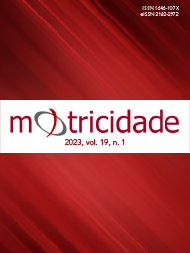The effects of preventive shoulder exercises in electromyographic and pain levels in child swimming athletes - A before-after analysis
DOI:
https://doi.org/10.6063/motricidade.27461Palavras-chave:
Electromyography, Pain, Shoulder, SwimmersResumo
The aim of this study was to evaluate maximum voluntary contraction through surface electromyography in stabilizer shoulder muscles, as well as the clinical evaluation of shoulder injury in the pre, post, and detraining stages of specific training in child swimmers. Twelve competitive swimmers volunteered for this study. Anthropometric measurements, clinical examination, electromyography (with Delsys® data acquisition system), and pain intensity levels were performed. Clinical examination and EMG data were compared using repeated-measures ANOVA with Bonferroni correction pre, post, and after detraining. The intervention program lasted for 12 weeks. The pain group presented higher pain intensity values compared to the post-intervention program. Most of the tests presented lower values at the detraining compared to the baseline. After the intervention, pain levels significantly decreased in five tests. Muscle strengthening work is highly recommended because it improves the swimmer's shoulder performance, reducing injuries and decreasing pain intensity after 12 weeks of intervention.
Downloads
Publicado
Edição
Secção
Licença
Os autores dos manuscritos submetidos para publicação deverão ceder, a título integral e permanente, os direitos de autor (copyright) à revista Motricidade e às Edições Desafio Singular. A cedência de direitos de autor permite a publicação e divulgação do artigo em formato impresso ou eletrónico e entrará em vigor a partir da data de aceitação do manuscrito. Os autores concedem, ainda, os direitos para a revista Motricidade utilizar e explorar o respetivo artigo, nomeadamente para licenciar, ceder ou vender o seu conteúdo a bases de resumos/indexação ou outras entidades.
Nos termos da licença “Creative Commons”, os autores poderão reproduzir um número razoável de exemplares para uso pessoal ou profissional, mas sem fins comerciais. Nos termos da licença SHERPA/RoMEO, os autores poderão, ainda, disponibilizar/arquivar uma cópia digital final (versão postprint) do artigo no seu website ou no repositório científico da sua instituição.

